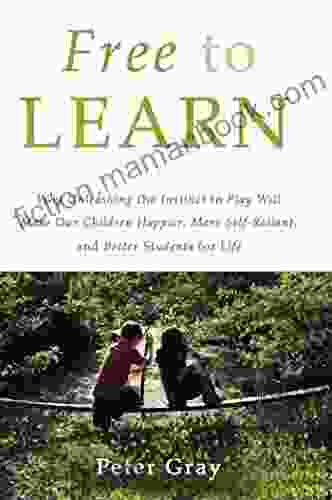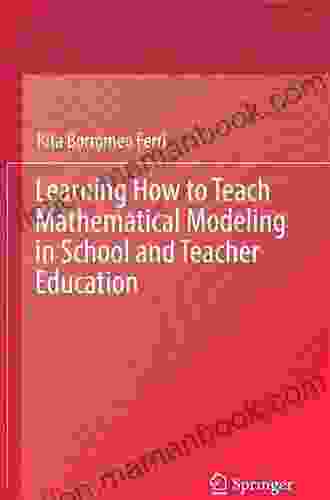Learning How to Teach Mathematical Modeling in School and Teacher Education

Mathematical modeling is a powerful tool that can be used to solve problems, make predictions, and understand the world around us. It is an essential skill for students in all fields, and it is becoming increasingly important in the workplace.
4.1 out of 5
| Language | : | English |
| File size | : | 4000 KB |
| Text-to-Speech | : | Enabled |
| Screen Reader | : | Supported |
| Enhanced typesetting | : | Enabled |
| Word Wise | : | Enabled |
| Print length | : | 174 pages |
Despite its importance, mathematical modeling is often not taught well in schools. This is due to a number of factors, including:
* A lack of understanding of what mathematical modeling is and how it can be used * A lack of resources and materials for teaching mathematical modeling * A lack of professional development opportunities for teachers
As a result, many students graduate from school without the skills they need to use mathematical modeling effectively. This can have a significant impact on their success in college and careers.
The good news is that there are a number of things that can be done to improve the teaching of mathematical modeling in schools. These include:
* Providing teachers with more training and support * Developing new resources and materials for teaching mathematical modeling * Incorporating mathematical modeling into the curriculum * Assessing students' understanding of mathematical modeling
By taking these steps, we can help ensure that all students have the opportunity to learn this important skill.
What is Mathematical Modeling?
Mathematical modeling is the process of using mathematics to represent a real-world situation. This can be done in a variety of ways, depending on the situation and the purpose of the model.
Some of the most common types of mathematical models include:
* Linear models: These models are used to represent relationships between two or more variables that are proportional to each other. * Nonlinear models: These models are used to represent relationships between two or more variables that are not proportional to each other. * Differential equations: These models are used to represent relationships between variables that change over time. * Partial differential equations: These models are used to represent relationships between variables that change over time and space.
Mathematical models can be used to solve a wide variety of problems, including:
* Predicting the weather * Forecasting economic trends * Designing new products * Optimizing processes
Mathematical modeling is a powerful tool that can be used to make better decisions and understand the world around us.
How to Teach Mathematical Modeling
There are a number of different approaches to teaching mathematical modeling. However, some of the most effective approaches include:
* Inquiry-based learning: This approach involves students in the process of developing and testing mathematical models. Students are given a problem to solve, and they must use their own knowledge and skills to create a model that can solve the problem. * Project-based learning: This approach involves students in a long-term project that requires them to use mathematical modeling to solve a real-world problem. Students work in teams to research the problem, develop a model, and present their findings. * Direct instruction: This approach involves the teacher directly teaching students the concepts and skills needed to use mathematical modeling. Students are given examples of mathematical models, and they are taught how to create and use models to solve problems.
The best approach to teaching mathematical modeling will vary depending on the age and abilities of the students. However, all of the approaches listed above can be effective in helping students learn this important skill.
Assessment of Mathematical Modeling
It is important to assess students' understanding of mathematical modeling. This can be done in a variety of ways, including:
* Written assignments: Students can be asked to write essays or reports that explain their understanding of mathematical modeling. * Oral presentations: Students can be asked to give oral presentations in which they explain their understanding of mathematical modeling. * Projects: Students can be asked to complete projects that require them to use mathematical modeling to solve real-world problems. * Quizzes and tests: Students can be given quizzes and tests to assess their knowledge of the concepts and skills of mathematical modeling.
By assessing students' understanding of mathematical modeling, teachers can help ensure that students are learning this important skill.
Professional Development for Teachers
Teachers need professional development to learn how to teach mathematical modeling effectively. This professional development can include:
* Workshops: Workshops can provide teachers with hands-on experience with mathematical modeling. * Conferences: Conferences can provide teachers with opportunities to learn about the latest research and best practices in teaching mathematical modeling. * Online courses: Online courses can provide teachers with flexible and convenient opportunities to learn about mathematical modeling.
By participating in professional development, teachers can improve their knowledge and skills in teaching mathematical modeling.
Mathematical modeling is an essential skill for students in all fields. It can help students solve problems, make predictions, and understand the world around them. However, mathematical modeling is often not taught well in schools. This is due to a number of factors, including a lack of understanding of what mathematical modeling is and how it can be used, a lack of resources and materials for teaching mathematical modeling, and a lack of professional development opportunities for teachers.
By taking steps to improve the teaching of mathematical modeling in schools, we can help ensure that all students have the opportunity to learn this important skill.
References
* [1] Blum, W., & Borromeo Ferri, R. (2009). Mathematical modeling: Problem-based mathematics from primary to secondary school level. In F. K. J. H. van den HeuvelPanhuizen (Ed.),Children's minds in motion: Proceedings of the 2008 international conference on the learning of mathematics (pp. 307-318). Utrecht, The Netherlands: Freudenthal Institute, Utrecht University. * [2] Lesh, R., & Doerr, H. M. (2003). Beyond constructivism: Models and modeling perspectives on mathematics problem solving, learning, and teaching. Mahwah, NJ: Lawrence Erlbaum Associates. * [3] National Council of Teachers of Mathematics. (2000). Principles and standards for school mathematics. Reston, VA: National Council of Teachers of Mathematics. * [4] Niss, M. (2003). Mathematical modeling in the teaching of mathematics: Some challenges and perspectives. In M. A. Clements, A. Bishop, C. Keitel, J. Kilpatrick, & F. Leung (Eds.),Third international handbook of mathematics education (pp. 115-136). Dordrecht, The Netherlands: Kluwer Academic Publishers.
4.1 out of 5
| Language | : | English |
| File size | : | 4000 KB |
| Text-to-Speech | : | Enabled |
| Screen Reader | : | Supported |
| Enhanced typesetting | : | Enabled |
| Word Wise | : | Enabled |
| Print length | : | 174 pages |
Do you want to contribute by writing guest posts on this blog?
Please contact us and send us a resume of previous articles that you have written.
 Top Book
Top Book Novel
Novel Fiction
Fiction Nonfiction
Nonfiction Literature
Literature Paperback
Paperback Hardcover
Hardcover E-book
E-book Audiobook
Audiobook Bestseller
Bestseller Classic
Classic Mystery
Mystery Thriller
Thriller Romance
Romance Fantasy
Fantasy Science Fiction
Science Fiction Biography
Biography Memoir
Memoir Autobiography
Autobiography Poetry
Poetry Drama
Drama Historical Fiction
Historical Fiction Self-help
Self-help Young Adult
Young Adult Childrens Books
Childrens Books Graphic Novel
Graphic Novel Anthology
Anthology Series
Series Encyclopedia
Encyclopedia Reference
Reference Guidebook
Guidebook Textbook
Textbook Workbook
Workbook Journal
Journal Diary
Diary Manuscript
Manuscript Folio
Folio Pulp Fiction
Pulp Fiction Short Stories
Short Stories Fairy Tales
Fairy Tales Fables
Fables Mythology
Mythology Philosophy
Philosophy Religion
Religion Spirituality
Spirituality Essays
Essays Critique
Critique Commentary
Commentary Glossary
Glossary Bibliography
Bibliography Index
Index Table of Contents
Table of Contents Preface
Preface Introduction
Introduction Foreword
Foreword Afterword
Afterword Appendices
Appendices Annotations
Annotations Footnotes
Footnotes Epilogue
Epilogue Prologue
Prologue Greg Stine
Greg Stine Peter Swan
Peter Swan Deanna Chase
Deanna Chase Content Arcade Publishing
Content Arcade Publishing George Tsakraklides
George Tsakraklides Kimberly Denney
Kimberly Denney Sara Bourgeois
Sara Bourgeois Lisa Mills
Lisa Mills George Gershwin
George Gershwin Michael Pickell
Michael Pickell Peter Robison
Peter Robison Christopher Ellison
Christopher Ellison Federal Aviation Administration Staff
Federal Aviation Administration Staff Pippa Dacosta
Pippa Dacosta Daniel Lincoln
Daniel Lincoln Daniel Humm
Daniel Humm Peter Gray
Peter Gray Rohini Gupta
Rohini Gupta David Shapiro
David Shapiro Trifon Marchovski
Trifon Marchovski
Light bulbAdvertise smarter! Our strategic ad space ensures maximum exposure. Reserve your spot today!

 Brent FosterHow Iron Helps Us Breathe, Potassium Lets Us See, and Other Surprising Ways...
Brent FosterHow Iron Helps Us Breathe, Potassium Lets Us See, and Other Surprising Ways... Blake KennedyFollow ·19.9k
Blake KennedyFollow ·19.9k Henry GreenFollow ·4k
Henry GreenFollow ·4k Fletcher MitchellFollow ·7k
Fletcher MitchellFollow ·7k Luke BlairFollow ·16k
Luke BlairFollow ·16k Roberto BolañoFollow ·13.5k
Roberto BolañoFollow ·13.5k Jonathan HayesFollow ·5.9k
Jonathan HayesFollow ·5.9k Blake BellFollow ·15.3k
Blake BellFollow ·15.3k Harvey BellFollow ·9.9k
Harvey BellFollow ·9.9k

 Abe Mitchell
Abe MitchellWhy Unleashing the Instinct to Play Will Make Our...
Play is an essential part of childhood. It is...

 Rubén Darío
Rubén DaríoTheory in Health Promotion Research and Practice
Theory is essential...

 Howard Blair
Howard BlairFailing Students or Failing Schools: Uncovering the Root...
In the United States, the issue of failing...

 Ira Cox
Ira CoxPoetry From the Heart Chope: A Symphony of Soul and Verse
Embark on a literary...

 Easton Powell
Easton PowellThe Witch Hunt: Wicked Witches of Shadow Woods
In the cursed woods of...
4.1 out of 5
| Language | : | English |
| File size | : | 4000 KB |
| Text-to-Speech | : | Enabled |
| Screen Reader | : | Supported |
| Enhanced typesetting | : | Enabled |
| Word Wise | : | Enabled |
| Print length | : | 174 pages |












